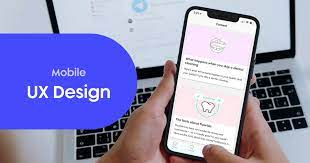In most cases, the User Experience is what separates a good app from a bad app (UX). People nowadays expect a lot from a mobile app, such as ease of use, quick loading times, and enjoyable interaction. If you want your app to be successful, UX should be a key component of your product strategy.
What is included in the UX Design of a Mobile App?
The app for mobile devices The subjective experience a user has while using the app is referred to as UX. The process of creating a mobile app that is simple and enjoyable to use is known as UX design. As a result, users have a more relevant and meaningful experience.
User Interface is a component of User Experience, but it is not the only component.
Many people confuse user experience with user interface (UI). UX design entails more than just UI design for mobile apps. The developers consider aspects such as content, sound design, and user interaction when designing the UX. The creation of a great user interface is only one aspect of a great user journey experience on an app.
Why is it critical to create a flawless user experience?
As previously stated, User Experience encompasses far more than just the User Interface. It goes beyond design to give users a better experience before, during, and after they use the app.
When designing a mobile user experience, there are a few things to keep in mind.
There are some areas where mobile app development companyUX design differs from desktop UX design. As a result, for mobile users, some principles will change:
1. Screen Dimensions
Mobile apps provide a more personalised and convenient way to access information that was previously only available through websites. If you only shrink the website to a common size of 5 – 6-inch mobile device when creating a mobile app, the design may look inferior, and the navigation on the app may be confusing to the user.
In contrast to websites and desktop applications, where you can present information on a larger screen, the information on mobile app screens should be well-thought-out due to the smaller size and layout available. As a result, you should focus on identifying and prioritising the information that is most important and relevant to users, because on mobile, you only have one column in which to place all of the content.
2. Orientation of the screen
The user of a mobile device can change the screen orientation. According to studies, users prefer to use their screens vertically nearly 94% of the time and horizontally the rest of the time.
Only one thumb is preferred by 49% of users when using their smartphones. The smaller the screen, the less one can comfortably reach with one thumb. 36 percent of users navigate with one thumb while holding the phone in one palm. In contrast, 15% of users use both thumbs to operate the phone.
You must ensure that your app's user experience is excellent with both of these orientation aspects when designing it for mobile devices. Users will be able to use the entire mobile screen and will have a more pleasant user experience as a result.
The first step is to desgn your mobile app in such a way that it can be used in both orientations. Second, you should place your app's clickable icons and features in places where users can easily and comfortably reach them.
3. Input and navigation
The only way for mobile users to interact with the app is through a standard touch screen. They don't have a mobile phone with a keyboard attached to it (in most cases). As a result, you should provide them with a variety of input methods on mobile, as opposed to desktop users. On a mobile device, for example, a numeric keypad should appear when the user is supposed to type in numbers, and a Qwerty keypad should appear when the user is supposed to type in letters.
Another aspect of navigation to consider is the size and spacing between action icons. Users are more likely to make mistakes if there are too many action icons close together. You should make sure that the action icons/buttons are large enough to tap and that they are separated from one another by a safe distance.
Touch isn't the only way to interact with the app; users can also use touch gestures. Sliding, scrolling, tapping (short, long, double), and pulling down are the most common gestures on mobile phones. For example, zooming into a picture with a double-tap is a common gesture.
4. The natural world
In both casual and professional settings, mobile phones are used. They are almost universally used, regardless of the user's location. Because carrying a laptop all of the time is difficult, most users prefer to use their mobile phones for all of their needs. This could be done by surfing the internet, reading the news, listening to music, or sending an email to a client.
As a result, you can be confident that your users will use your app regardless of their location or environment. This necessitates the development of an app that can be used almost anywhere. To ensure that the user can easily see and understand the information on your app, you should use high contrast colours that allow the user to see the information even in bright sunlight.
5. There is no split screen
Even though newer smartphones have split-screen capabilities, it is not widely used by users. As a result, it's critical that you design your app's user interface as if the user's smartphone lacks split-screen functionality. If your app is an e-wallet, for example, you should provide features like currency exchange rates and other financial services to your users. If you don't, the user may abandon your app to check currency exchange rates, or they may be tempted to close it entirely. He can also uninstall the app later.
Expert tip: Always try to keep users in your app by providing them with everything they might require while using it. Also, never redirect the user to a browser screen for registration or login.
In 2021, the best UX design software will be
It is undeniably critical to create the best possible user experience. But how do you go about doing that? There are software tools available to assist designers with user experience design. Wireframing is the first step in the UX design process, followed by prototyping and finally the final design.





